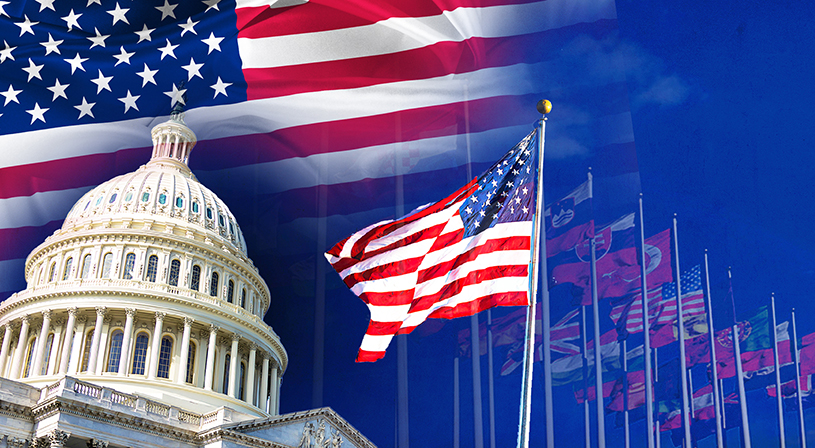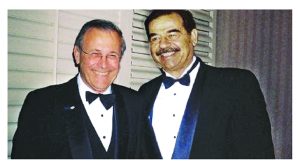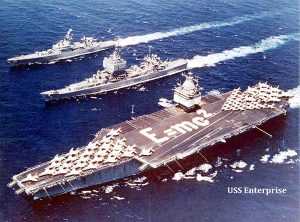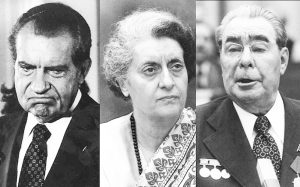Failed American Foreign Policy
By Dr. Arvind Suresh
A Trail of Miscalculations, Betrayals, Moral Blindness and Double Standards

The United States of America has positioned itself as a global superpower over the past few decades, frequently promoting the ideals of justice, freedom, and democracy. However, a more thorough examination of its foreign policy reveals a history of poor decisions, ill-advised alliances, and tactical ploys that have not only destabilized areas but also, frequently, given adversaries more power. From the Cold War to the present, the United States has frequently supported dictators, sided with the wrong side in wars, incited future adversaries, and meddled in domestic affairs with disastrous results. American foreign policy has frequently taken the wrong side of history, from arming future adversaries like Saddam Hussein and Osama bin Laden to supporting authoritarian governments and even deploying warships against democracies. In addition to costing the US trillions of dollars and thousands of lives, these mistakes have damaged the country’s reputation around the world.
America’s Own Products: Osama bin Laden and Saddam Hussein
The formation of enemies that the United States eventually engages in combat with is one of the most obvious trends in its foreign policy. Osama bin Laden and Saddam Hussein, two of the most notorious figures in contemporary history, were not only America’s enemies but also its allies at one point, carefully cultivated by American policy to further American objectives.

Donald Rumsfeld with Saddam Hussein
Following the Islamic Revolution in 1979, the United States backed Saddam Hussein’s government in Iraq as a counterweight to Iran during the Cold War. Washington ignored his repressive practices and even contributed resources and intelligence during the 1980s Iran-Iraq War. After Saddam invaded Kuwait in 1990, the West that had previously supported his ascent was compelled to engage in an expensive and protracted conflict, first in Operation Desert Storm and then in the 2003 Iraq War, which caused instability throughout the Middle East.
Osama bin Laden’s story takes a similar course. The United States provided the mujahideen, or radical Islamic fighters opposing Soviet occupation, with billions of dollars in arms and training during the Soviet-Afghan War in the 1980s. “One of the beneficiaries of this anti-Soviet jihad was Bin Laden, a Saudi national. The same man would go on to mastermind the 9/11 attacks on American soil years later, starting a war on terror that has cost trillions of dollars, thousands of American lives, and innumerable civilian casualties in Afghanistan, Iraq, and other places.”
The irony is harsh: the United States contributed to the creation of monsters it later had to battle, demonstrating a pattern of shortsighted strategies with long-term repercussions.
Supporting the Wrong Side of History in the 1971 Bangladesh War

President Reagan meeting with Afghan Mujahideen in the White House to
discuss Soviet invasion of Afghanistan
The United States’ decision to support Pakistan during the 1971 Bangladesh Liberation War, in spite of overwhelming evidence of genocide by the Pakistani military in East Pakistan (now Bangladesh), was arguably one of its most disgraceful actions.
One of the biggest genocides of the 20th century, it claimed the lives of over three million people and raped hundreds of thousands of women.
As East Pakistan (now Bangladesh) struggled against West Pakistan’s violent repression, India backed the Bengali independence movement. Due in large part to the fact that India was viewed as being too close to the Soviet Union and Pakistan had acted as a backchannel to China, President Richard Nixon and his advisor Henry Kissinger supported General Yahya Khan’s authoritarian government rather than democratic goals and humanitarian concerns.
One of the most contentious actions was the United States’ deployment of the Seventh Fleet into the Baforce display intended to scare India, which was harboring more than 10 million refugees escaping the horrors in Pakistan. This was a moral failure as well as a sign of geopolitical imbalance. The United States’ refusal to take action against Pakistan in the face of copious reports of mass rape and genocide by the Pakistani military alienated the people of Bangladesh and tarnished its reputation as a human rights advocate.
In the end, India won, and Bangladesh became a sovereign state. However, the United States’ involvement in one of the worst humanitarian crises of the 20th century left it with a damaged reputation and a foreign policy marred by complicity.
Double Standards: 9/11 vs. 26/11 Mumbai Attacks

Photo : X.com.
USA sent 7th Fleet’s Task Force, led by the nuclear-powered
aircraft carrier USS Enterprise, to the Bay of Bengal.
Following the 26/11 Mumbai terror attacks in 2008, there was arguably one of the most devastating betrayals of Indian public sentiment. In a startling, multi-day siege of India’s financial capital, terrorists from the Lashkar-e-Taiba group, who were trained and led by handlers in Pakistan, killed 175 innocent people and injured hundreds more.
However, the U.S. repeatedly urged India to “exercise restraint” rather than supporting India in taking decisive action against Pakistan. Using the justification that a military reaction would worsen regional instability, American officials used covert diplomacy to defuse the situation.
In contrast, the United States responded to 9/11 by launching a full-scale war in Afghanistan in an effort to destroy al-Qaeda and find Osama bin Laden. The United States reaffirmed its right to unilateral retaliation and called for international solidarity. Despite the overwhelming evidence of Pakistani involvement, that right was not extended to India. The moral and strategic inconsistency of U.S. foreign policy was brought to light by this double standard, which holds that American lives incite wars while Indian lives necessitate patience.
Trump, Tactical Flattery, and Asim Munir
The same pattern recurs in the present. Known for his erratic foreign policy, President Donald Trump once took a strong stance against Pakistan, denouncing its support of terrorists and even halting aid. But in a total 180-degree turnabout, Trump and his administration started praising General Asim Munir, the current Army Chief of Pakistan, who is generally regarded as the mastermind behind the detention of former Prime Minister Imran Khan and the strengthening of military rule over civilian matters in Pakistan.
It seems that short-term strategic interests—possibly to gain limited counterterrorism cooperation or regional leverage over Afghanistan—are driving this tactical engagement with Munir. However, history cautions us about the dangers of this route. The United States once again runs the risk of strengthening an organization that has continuously weakened democracy, encouraged extremism, and destabilized South Asia by recognizing and interacting with Pakistan’s military deep state.
The Ultimate Quagmire: The Vietnam War

President Nixon, Prime Minister Gandhi and Soviet Premier Leonid Brezhnev
The Vietnam War is an essential component of any list of failed U.S. foreign policy initiatives. What started out as an effort to restrain communism became a catastrophe that lasted for two decades. The United States was unable to stop the fall of Saigon in 1975, even with massive troop deployments, billions of dollars spent, and more than 58,000 American lives lost. Vietnam came to represent American hubris, poor intelligence, and overreach. In addition, the war caused a great deal of disenchantment with government institutions and a deep rift in American society.
Iran 1953: A Coup That Backfired
The Shah was reinstated in 1953 after the United States and Britain planned a coup to remove Mohammad Mossadegh, Iran’s democratically elected prime minister. Long-term animosity among Iranians was sown by this short-term victory for oil interests. The outcome was the hostage crisis, the Islamic Revolution of 1979, and decades of hostility that continue to influence U.S.-Iranian relations today. The current Iranian theocracy frequently uses American meddling as an excuse for its anti-Western views.
Afghanistan 2001–2021: From Nation-Building to Abandonment
The initial goal of the U.S. intervention in Afghanistan was to destroy al-Qaeda. However, over the course of two decades, the mission changed to nation-building, supporting corrupt regimes, and investing more than $2 trillion in an undefined war. The Taliban regained power after the Afghan government collapsed spectacularly as a result of the sudden withdrawal in 2021. The war ended in humiliation rather than victory, and thousands of Afghans who backed the United States were left behind.
Libya 2011: From Humanitarian Intervention to Chaos

Photo:X.com
The United States spearheaded a NATO bombing campaign against Muammar Gaddafi’s government in Libya under President Obama. Although Gaddafi was overthrown, the operation left the nation in ruins. Warring militias, open slave markets, and continuous foreign meddling characterize Libya as a failed state today. Libya has become a case study of how regime change without a post-war plan breeds instability as a result of this “intervention without strategy.”
Syria: Inaction and Confusion
American foreign policy in Syria suffered from paralysis and inconsistency rather than overreach. President Obama’s notorious “red line” warning about chemical weapons was not followed, which allowed Bashar al-Assad to gain confidence and damaged American credibility. America later supported rebels against Assad, many of whom had ties to extremist organizations. The outcome? ISIS’s ascent, a protracted civil war, a severe refugee crisis, and Assad’s consolidation with Iranian and Russian backing.
Latin America: Endless Interference, No Advancement
“The United States’ engagement in Latin America has frequently stoked violence, corruption, and anti-American sentiment, from aiding the Contras in Nicaragua to supporting military takeovers in Chile (1973), Guatemala (1954), and Bolivia (2019).” Decades of instability have resulted from these interventions, which are nearly always defended as pro-stability or anti-communist actions. They have also weakened democratic movements throughout the region.
Backing Dictators and Suppressing Democracies

Photo:X.com
In the name of combating terrorism or communism, the United States has supported authoritarian governments and military juntas throughout the 20th and early 21st centuries. U.S. foreign policy has frequently supported tyrants at the expense of their people’s desire for democracy, from Pinochet in Chile to Mobutu in Congo, from the Shah of Iran to Hosni Mubarak in Egypt. These partnerships may have provided short-term economic benefit or stability, but they also planted the seeds of radicalization and long-term animosity.
Despite Saudi Arabia’s appalling human rights record and its role in exporting Wahhabism, the United States’ support for the monarchy in the Middle East runs counter to its claims of promoting liberal values. In a similar vein, Washington’s unquestioning backing of Israel despite growing settlements and hostilities with Palestinians feeds anti-American sentiment throughout the Muslim world.
U.S. Entry into the Russia–Ukraine War
Since Russia’s invasion of Ukraine in February 2022, tens of thousands of people have lost their lives and millions have faced displacement. With more than $118 billion in military assistance and about $67 billion in direct security support alone, the United States has been Ukraine’s main supporter.
But both domestically and internationally, this enormous U.S. commitment has spurred political and strategic discussions. Some contend that Washington is essentially using Ukraine as a stand-in, extending the conflict to undermine Russia, possibly at significant financial and humanitarian expense. Others warn that the US has exerted pressure on Kyiv to make harsh concessions, such as acknowledging Russian sovereignty over Crimea.
Russia has intensified its own military action in Ukraine as the Middle East crisis worsens, indicating that Moscow may be able to gain leverage if the world focuses on other hotspots. The outcome remains uncertain, and the United States must now balance its support for Ukraine with emerging international crises.
U.S. Involvement in the Israel–Hamas War and Escalation with Iran

Photo:X.com
In the ongoing conflict between Israel and Hamas, American military posture and diplomacy have been crucial. Widespread international condemnation of the civilian deaths in Gaza has put the U.S.’s influence to the test, despite the fact that it has given Israel diplomatic cover and security assistance.
Above all, the United States recently joined Israel in bombing Iran’s nuclear sites, marking the first direct American airstrikes on Iranian territory since possible nuclearization. Under “Operation Midnight Hammer,” U.S. B-2 stealth bombers and Tomahawk missiles attacked Iran’s nuclear enrichment facilities in Natanz, Fordow, and Isfahan on June 21–22, 2025.
Declaring the sites “totally obliterated,” President Trump praised the mission as a “spectacular military success.” However, experts warn that Iran might still have a significant amount of enriched uranium and nuclear infrastructure, which could be rebuilt in a matter of months. Fears of a wider regional conflict have increased as a result of Iran’s retaliation, which involved firing missiles at US bases in Qatar.
What’s at Stake—and Why the Jury’s Still OutThese events represent a dramatic escalation of U.S. involvement in multiple global conflicts:
| Conflict | U.S. Role | Risk/Outcome |
|---|---|---|
| Russia–Ukraine | Major arms & financial support | Risk of protracted engagement, donor fatigue, strategic overreach |
| Israel–Hamas | Diplomatic backing, military aid | Growing global backlash, questioning of U.S. impartiality |
| Israel–Iran | Direct military action | Risk of wide war, unclear nuclear impact, legal controversy |
The United States is currently involved in three high-stakes conflicts at the same time. The verdict is still pending. Will it become a powerful global leader that upholds deterrence and international norms? Instead, will these actions increase instability, deplete resources, and damage American credibility?
The answer to that will come with time and whether these regional crises settle or spiral. One thing is certain, though: the interventionism, moral ambiguity, and strategic risk that have defined American foreign policy for decades are all present in these most recent actions.
Short-Term Thinking, Long-Term Chaos
A pattern of short-term strategic thinking unites these mistakes. Regardless of the long-term effects, U.S. foreign policy frequently acts with tunnel vision, identifying a short-term adversary and standing by anyone who opposes it. The outcome has always been the same: empowered radicals, failed states, and backlash against the United States and its allies, regardless of whether it was arming the Taliban against the Soviets, flirting with Pakistan’s military rulers, or assisting authoritarian regimes under the pretense of stability.
The Cost of Failure
These failed policies come at a huge cost:
Human cost: Millions have died in wars that the U.S. either started, escalated, or sustained—Vietnam, Iraq, Afghanistan, Syria, Libya.
Financial cost: With little return on investment or goodwill, trillions of taxpayer dollars have been spent on wars and military assistance.
Moral cost: The United States’ reputation has suffered. From drone strikes to regime change, from Abu Ghraib to Guantanamo, the United States is increasingly viewed as a meddler rather than a liberator.
Strategic cost: American promises are now viewed with suspicion by many nations. While adversaries take advantage of contradictions, allies are uncertain about long-term commitments.
Rethinking American Power
 A perilous pattern—short-term thinking, opportunistic alliances, moral blindness, and a disregard for long-term consequences—unites all of these cases. Too frequently, corporate interests, ideological anxieties, and tactical calculations have influenced American foreign policy more than moral leadership.
A perilous pattern—short-term thinking, opportunistic alliances, moral blindness, and a disregard for long-term consequences—unites all of these cases. Too frequently, corporate interests, ideological anxieties, and tactical calculations have influenced American foreign policy more than moral leadership.
America needs to start doing the right thing, even if it is not convenient at the moment, instead of making monsters to fight monsters or going for the “lesser evil.” Only then will the country be able to recover its moral leadership and steer clear of the mistakes that have characterized so much of its post-war history.
The inequity and imbalance at the heart of American strategy are exemplified by its refusal to support India after 26/11 while pleading for international sympathy after 9/11. America asks others to exercise restraint, even when their suffering is similar to its own, even though it retains the right to take decisive action in its own best interests.
In addition to undermining America’s reputation abroad, these mistakes have fostered anti-American sentiment, left radicals in positions of power, and violated the very principles that the United States professes to support. A fundamental rethinking of U.S. foreign policy is needed, one that is based on multilateral cooperation, long-term vision, and a dedication to justice rather than merely strategic advantage.
There is still hope for the United States to be a positive influence on the world. Indeed, nations can be inspired by its guiding principles of democracy, justice, and liberty. However, this is only possible if foreign policy supports these values rather than running counter to them. It is imperative to adopt a new strategy based on long-term vision, moral partnerships, and strategic humility. Only then will America be able to lead by example rather than by coercion or fear.
About the Author:
Dr. Arvind Suresh is an Indian-American scholar of international affairs, currently based in Washington, D.C. He earned his Ph.D. in political science with a focus on U.S. foreign policy and global strategic relations. Dr. Suresh specializes in analyzing America’s diplomatic, economic, and security engagements with major world powers.
He has served as an advisor to various government agencies and international organizations on matters of global diplomacy.His research explores shifting alliances, geopolitical risks, and the role of the U.S. in a multipolar world. Widely respected in academic and policy circles, he frequently participates in international forums and expert panels.
Dr. Suresh is committed to fostering cross-cultural dialogue and developing policy solutions for global cooperation.




























